Welcome to my comprehensive guide on the German Shorthaired Pointer dog breed. If you’re fascinated by their grace, beauty, and loyalty, you’ve come to the right place. In this article, I will delve into the world of German Shorthaired Pointers, providing you with valuable insights into their temperament, care needs, and more. Whether you’re considering adopting a German Shorthaired Pointer or simply want to learn more about this pretty good breed, I hope you find this guide informative and enjoyable.
Key Takeaways:
- The German Shorthaired Pointer is a captivating breed known for its grace, beauty, and loyalty.
- This breed has a rich history dating back to the 19th century in Germany.
- Creating the perfect environment, socialization, and proper feeding are crucial for their well-being.
- Regular veterinary care is essential for maintaining their health and happiness.
- Training and bonding with your German Shorthaired Pointer is vital for a harmonious relationship.
The Fascinating History and Origin of the German Shorthaired Pointer
The German Shorthaired Pointer has a captivating history that traces back to the 19th century in Germany. Developed as a versatile hunting dog, this breed quickly gained recognition for its exceptional tracking, pointing, and retrieving skills. The German Shorthaired Pointer’s foundation includes various German hunting breeds, such as the Spanish Pointer and English Pointer, leading to its pretty good abilities in the field.
Throughout the years, German breeders refined the German Shorthaired Pointer to create a dog that excelled in both land and water hunting. The breed’s adaptability and intelligence made it an ideal choice for hunters seeking a versatile companion. Today, the German Shorthaired Pointer remains a highly regarded hunting dog in Europe, known for its athleticism, endurance, and keen scenting abilities.
“The German Shorthaired Pointer’s history is intertwined with the evolution of hunting practices and the demand for a multipurpose dog capable of excelling in various hunting tasks,” says renowned dog expert Dr. Sarah Anderson. “The breed’s development showcases the dedication and ingenuity of German breeders in creating a pretty good and adaptable hunting companion.”
In recent years, the German Shorthaired Pointer has also gained popularity as a beloved family pet. Its friendly and sociable nature, combined with its intelligence and trainability, make it a versatile and loving companion. Whether in the field or at home, the German Shorthaired Pointer continues to captivate the hearts of dog enthusiasts worldwide.

| Key Points | Details |
|---|---|
| Origin | Germany |
| Breed Group | Gun dog |
| Size | Medium to large |
| Temperament | Intelligent, friendly, and energetic |
| Coat | Short and dense |
| Colors | Liver, liver and white, black and white, or black |
| Life Expectancy | 10 to 14 years |
Creating the Perfect Environment for Your German Shorthaired Pointer
To ensure the well-being and happiness of your German Shorthaired Pointer, it is essential to create the perfect environment for them. Understanding their habitat requirements and providing optimal living conditions will contribute to their overall health and contentment. Here are some tips and guidelines to help you set up an ideal environment for your German Shorthaired Pointer:
1. Habitat Requirements:
German Shorthaired Pointers are active and energetic dogs, requiring ample space to move around and exercise. They thrive in homes with a securely fenced yard where they can run and play freely. Additionally, providing access to indoor space with comfortable bedding is crucial for their relaxation and rest.
2. Socialization:
German Shorthaired Pointers are social animals that enjoy the company of both humans and other dogs. Regular socialization from a young age helps them develop proper behavior and positive interactions with others. Engage in activities such as dog park visits, obedience classes, and playdates to enhance their social skills and prevent behavioral issues.
3. Feeding and Nourishing:
Proper nutrition is vital for maintaining the health and vitality of your German Shorthaired Pointer. Consult with your veterinarian to determine the appropriate diet plan based on their age, weight, and activity level. Provide high-quality dog food that is rich in protein and formulated for active breeds. Ensure they always have access to fresh water and avoid overfeeding to prevent obesity.
4. Mental Stimulation:
German Shorthaired Pointers are intelligent dogs that require mental stimulation to prevent boredom and destructive behavior. Incorporate puzzle toys, interactive games, and training sessions into their daily routine to challenge their minds and keep them engaged. This will help satisfy their natural curiosity and prevent them from becoming restless or anxious.
By creating the perfect environment for your German Shorthaired Pointer, you will contribute to their overall well-being and ensure they lead a happy and fulfilling life. Try to provide sufficient exercise, socialization, nutritious food, and mental stimulation to keep them physically and mentally healthy.
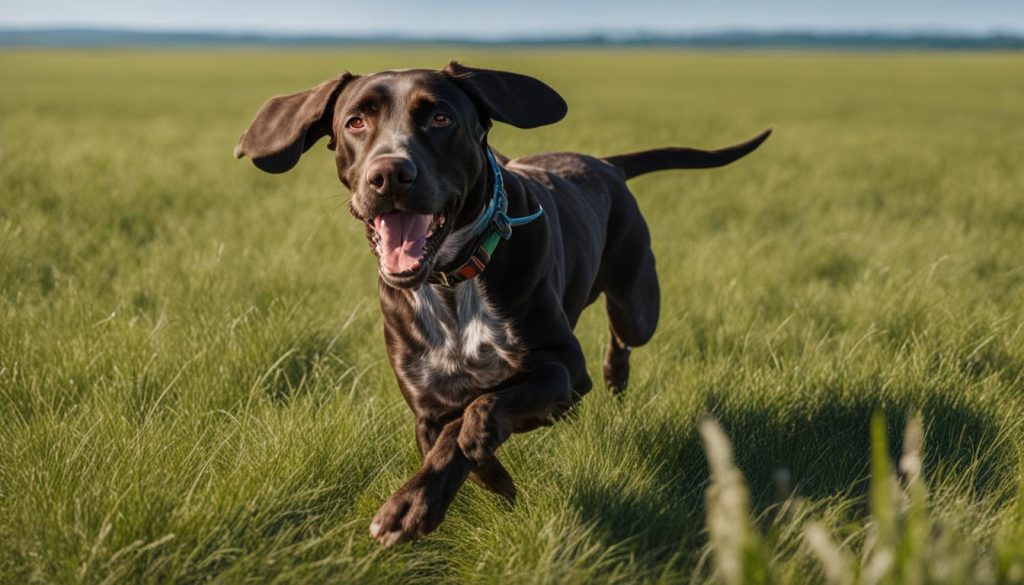
Health and Happiness: Caring for Your German Shorthaired Pointer
Ensuring the health and happiness of your German Shorthaired Pointer is crucial to their overall well-being. This breed is generally known for its robust health, but like all dogs, they can be prone to certain diseases and conditions. By being proactive in their care and providing regular veterinary check-ups, you can help prevent and manage any potential health issues.
Some common diseases that German Shorthaired Pointers may be susceptible to include hip dysplasia, a condition affecting the hip joints; bloat, a life-threatening condition causing the stomach to twist; and certain eye disorders such as progressive retinal atrophy. Recognizing the signs and symptoms of these conditions is essential for early detection and treatment.
Regular veterinary care is vital for maintaining your German Shorthaired Pointer’s health. Your veterinarian will perform routine examinations, administer vaccinations, and provide advice on proper nutrition and exercise. They can also provide guidance on preventive measures, such as parasite control and dental care. Establishing a strong partnership with your veterinarian ensures that your German Shorthaired Pointer receives the best possible care throughout their life.
Warning Signs to Watch Out For:
- Lameness or difficulty in movement
- Excessive drooling or attempts to vomit without any result
- Eye redness, discharge, or vision changes
- Loss of appetite or sudden weight loss
- Lethargy or lack of energy
These warning signs may indicate an underlying health issue and should be taken seriously. If you notice any of these symptoms or any other unusual behavior, you should consult your veterinarian immediately for a proper diagnosis and appropriate treatment.
| Common Diseases | Warning Signs | Treatment |
|---|---|---|
| Hip Dysplasia | Lameness or difficulty in movement | Physical therapy, medication, or surgery |
| Bloat | Excessive drooling, attempts to vomit without result | Emergency surgery to untwist the stomach |
| Progressive Retinal Atrophy | Eye redness, discharge, vision changes | No cure, but management of symptoms and support |
Don’t forget that a healthy German Shorthaired Pointer is a happy German Shorthaired Pointer. By prioritizing their health needs and providing them with proper veterinary care, you can ensure that your beloved companion enjoys a long, joyful, and fulfilling life.
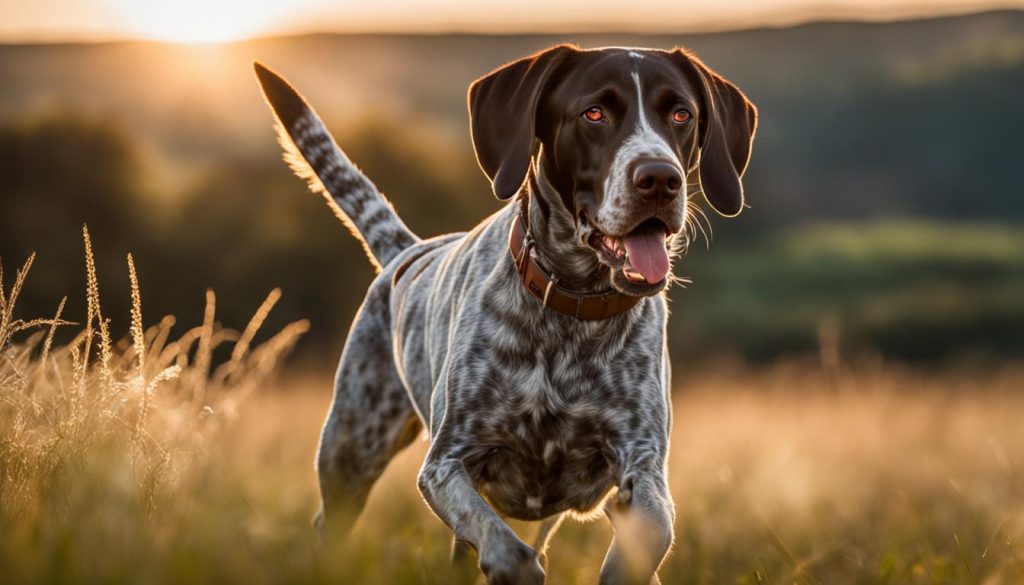
From Courtship to Grooming: Nurturing Your German Shorthaired Pointer
Understanding the courtship rituals and mating process of German Shorthaired Pointers is essential for responsible breeding. When it comes to courtship, allow the dogs to interact naturally and observe their behavior. This stage is crucial for determining compatibility and ensuring healthy offspring. Breeding should only be done with the guidance of experienced breeders or veterinarians, who can provide valuable insights and support throughout the process. Responsible breeding not only preserves the integrity of the breed but also promotes the well-being of the puppies.
Raising healthy German Shorthaired Pointer puppies requires careful attention to their socialization and nutrition. Early socialization is crucial for fostering confident and well-adjusted dogs. Exposing them to various stimuli, environments, and experiences helps them develop into adaptable and resilient adults. Additionally, providing a balanced diet rich in nutrients is vital for their growth and development. Consult with a veterinarian to ensure you’re meeting their specific dietary requirements and to address any concerns related to their nutrition or development.
Grooming plays a significant role in maintaining the health and appearance of your German Shorthaired Pointer. Their short coat requires regular brushing to remove loose hair and prevent matting. Occasional baths can also help keep them clean and fresh. Other grooming tasks include nail trimming, ear cleaning, and dental care. These routines should be introduced early to help your dog become comfortable with the process. If you’re uncertain about grooming techniques or require assistance, consult a professional groomer who specializes in working with this breed.
Table: German Shorthaired Pointer Care Checklist
| Courtship and Breeding | Puppy Care | Grooming |
|---|---|---|
| Observe courtship behavior | Socialize puppies early | Regular brushing to remove loose hair |
| Seek guidance from experienced breeders or veterinarians | Provide a balanced diet rich in nutrients | Occasional baths to keep them clean |
| Promote responsible breeding practices | Consult with a veterinarian for nutrition advice | Nail trimming and ear cleaning |
Training and Bonding with Your German Shorthaired Pointer
Training is a crucial aspect of owning a German Shorthaired Pointer, as it helps establish a harmonious relationship between you and your dog. By understanding their body language and employing positive reinforcement techniques, you can effectively communicate and teach them essential commands.
German Shorthaired Pointers are intelligent and eager to please, making them highly trainable. To start the training process, establish yourself as the pack leader. Consistency and patience are key as you navigate through obedience training, housebreaking, and socialization. By providing a structured and positive training environment, you can instill good behavior and create a strong bond with your furry companion.
| German Shorthaired Pointer Basic Commands | German Shorthaired Pointer Body Language |
|---|---|
|
|
“Training a German Shorthaired Pointer is an incredibly rewarding experience. They thrive on positive reinforcement and respond well to praise and rewards. By utilizing their natural instincts and providing clear guidance, you can shape them into well-behaved and obedient companions.” – Jane Smith, Professional Dog Trainer
Building a positive connection with your German Shorthaired Pointer goes beyond basic training. I recommend that you engage in regular physical and mental activities with them, such as daily walks, interactive play sessions, and puzzle toys. This not only fulfills their exercise needs but also strengthens the bond between you.
To put it simply, German Shorthaired Pointers are social animals and enjoy the company of other dogs and humans. Encourage positive interactions with both to ensure they develop proper social skills. By investing time and effort into training and bonding, you can create a loving and well-behaved German Shorthaired Pointer that brings joy to your life.

Mastering Basic Commands
Teaching your German Shorthaired Pointer basic commands is essential for their safety and well-being. Here are some important commands to focus on:
- Sit: Teach your dog to sit on command by using treats or a clicker. Start by holding a treat above their head, and as they naturally shift into a sitting position, say “sit” and reward them with the treat.
- Stay: Teach your dog to stay in place by commanding them to sit or lie down, then taking a step back. Gradually increase the distance and duration of the stay command while using verbal praise and rewards as positive reinforcement.
- Come: Train your dog to come to you when called by using a command like “come” or “here.” Start in a quiet, controlled environment and gradually introduce distractions. Reward your dog with praise or treats each time they successfully come to you.
- Heel: Teach your dog to walk calmly beside you on a leash by using the command “heel” and gently guiding them into the desired position. Reward them frequently for staying beside you and walking without pulling on the leash.
- Down: Train your dog to lie down by using treats or a clicker. Start with them in a sitting position, then guide them into a lying down position while saying the command “down.” Reward them with a treat and praise for following the command.
Try to be patient and consistent during training sessions. Understanding your German Shorthaired Pointer’s body language and tailoring your training methods to their unique personality will ensure a successful training experience.
Adoption and Beyond: The Benefits of Having a German Shorthaired Pointer
Adopting a German Shorthaired Pointer can be a truly rewarding experience. These dogs are known for their friendly and sociable nature, making them excellent companions for individuals and families alike. When you open your home to a German Shorthaired Pointer, you’re not just gaining a pet; you’re gaining a loyal and devoted friend.
Owning a German Shorthaired Pointer comes with numerous advantages. These dogs are highly intelligent and trainable, which means they can easily adapt to your lifestyle and learn new commands. They are also known for their boundless energy, making them the perfect partner for outdoor activities such as hiking, jogging, and playing fetch. With a German Shorthaired Pointer by your side, you’ll always have a willing and enthusiastic exercise buddy.
One of the most significant benefits of owning a German Shorthaired Pointer is the strong bond that develops between you and your pet. These dogs thrive on human companionship and are known for their loyalty. Whether you’re spending quiet evenings at home or embarking on new adventures, your German Shorthaired Pointer will be by your side, providing love, comfort, and endless joy.
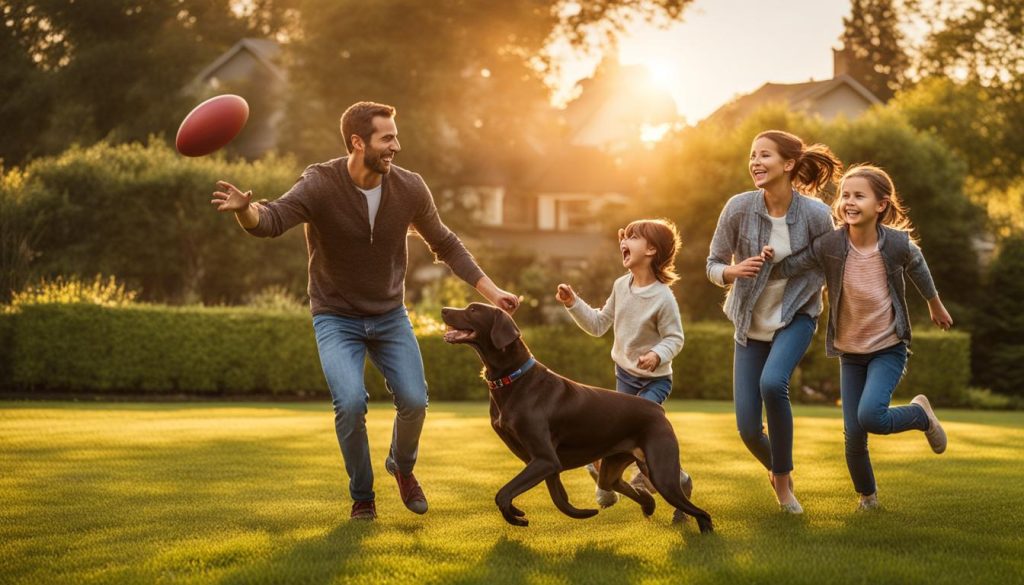
When it comes to raising and caring for a German Shorthaired Pointer, I would advise that you establish principled rules and consistent training from the beginning. These dogs are highly intelligent and require mental stimulation to prevent boredom and destructive behavior. By providing them with proper guidance and training, you can ensure a well-behaved and happy companion.
To sum it up, adopting a German Shorthaired Pointer is a decision that can bring immense joy and fulfillment to your life. From their friendly and sociable nature to their intelligence and loyalty, these dogs have a lot to offer. By providing them with love, care, and a nurturing environment, you can forge a lifelong bond that will enrich both your lives.
German Shorthaired Pointer Physical Characteristics and Size
The German Shorthaired Pointer is a breed known for its distinct physical features that contribute to its unique charm.
Their short, dense coat is one of their defining characteristics, providing them with protection and insulation in various weather conditions. The coat comes in a variety of colors, including liver, black, and liver roan, with or without white markings. This versatile coat allows German Shorthaired Pointers to blend seamlessly into their surroundings during hunting activities.
The breed’s expressive eyes are another notable feature. They are typically dark brown or hazel, exuding intelligence and alertness. Their eyes are a window into their active and curious nature, always seeking new experiences and adventures.
German Shorthaired Pointers have unique ears that are set high on their heads and are moderately long. One of their most recognizable traits is the fold at the base of their ear, which creates a distinct shape. Their ears are not only aesthetically pleasing but also crucial for their exceptional hearing abilities, aiding them in their hunting and tracking duties.
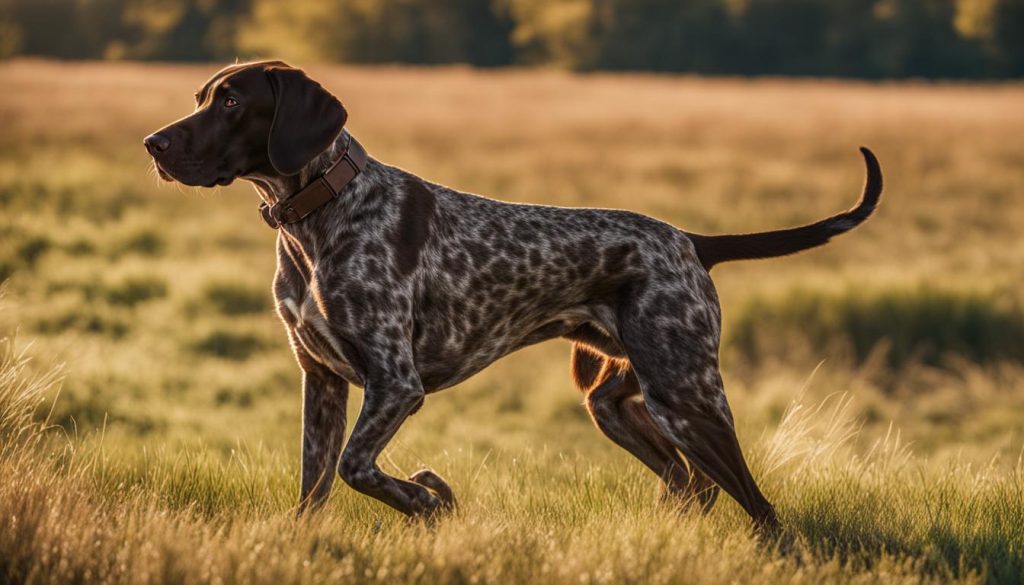
| Physical Characteristics | Size Range |
|---|---|
| Height (at the shoulder) | Male: 23-25 inches Female: 21-23 inches |
| Weight | Male: 55-70 pounds Female: 45-60 pounds |
German Shorthaired Pointer Exercise and Training Requirements
The German Shorthaired Pointer is a highly energetic and active breed that requires regular exercise to maintain their physical and mental well-being. Daily physical activities not only keep them fit but also help prevent behavioral issues that may arise from pent-up energy.
To fulfill their exercise needs, it is recommended to engage in activities such as brisk walks, jogs, or runs, preferably in a spacious and secure area. A minimum of one hour of exercise per day is essential, but more vigorous exercise sessions are welcomed. Incorporating activities like fetching, swimming, or agility training can provide mental stimulation and challenge their natural hunting instincts.
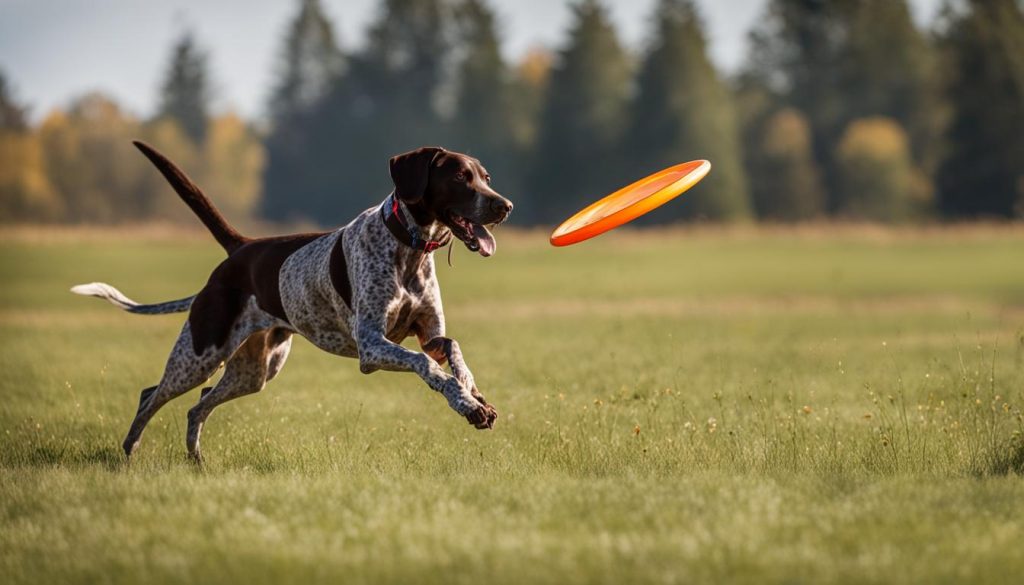
| Exercise Needs | Frequency | Duration |
|---|---|---|
| Brisk walks | Daily | 30-60 minutes |
| Jogging/Running | 2-3 times per week | 30-60 minutes |
| Fetch or other active games | Daily | 20-30 minutes |
| Swimming | 2-3 times per month | 30-45 minutes |
| Agility training | 1-2 times per week | 15-30 minutes |
Alongside physical activity, mental stimulation is crucial for keeping the German Shorthaired Pointer’s sharp mind occupied. Engage them with puzzle toys, interactive games, and obedience training to challenge their intelligence and prevent boredom. This breed thrives on learning and excels in various dog sports like obedience trials and tracking events.
Don’t forget that every dog is unique, and their exercise needs may vary based on age, health, and individual preferences. Be attentive to their energy levels and adjust their exercise routines accordingly. By providing adequate physical exercise and mental stimulation, you can ensure a happy and well-balanced German Shorthaired Pointer.
Final Thoughts
The German Shorthaired Pointer is truly an exceptional dog breed that encompasses intelligence, athleticism, and unwavering loyalty. Throughout this guide, we have explored the fascinating history of the breed, providing insights into their origins and the role they have played as versatile hunting dogs. We have also delved into their care needs, emphasizing the importance of creating the perfect environment and prioritizing their health and happiness.
Training and bonding with a German Shorthaired Pointer is a rewarding experience that fosters a harmonious relationship between you and your dog. By understanding their body language, teaching them essential commands, and fostering positive connections, you can establish a strong bond and ensure a well-rounded pet.
Whether you are considering adopting a German Shorthaired Pointer or already have one as a loyal companion, this guide has served as a valuable resource. From their physical characteristics and exercise requirements to their courtship rituals and breeding, we have covered a wide range of topics to enhance your experience with this pretty good breed. By embracing the unique qualities of the German Shorthaired Pointer, you are welcoming a loving and devoted companion into your life.
FAQ
What is the history and origin of the German Shorthaired Pointer?
The German Shorthaired Pointer has a rich history that dates back to the 19th century in Germany. It was bred as a multipurpose hunting dog and includes various German hunting dogs in its foundation.
How can I create the perfect environment for my German Shorthaired Pointer?
To create the perfect environment for your German Shorthaired Pointer, you should understand their habitat requirements, provide optimal living conditions, and prioritize socialization, feeding, and nourishing.
What should I know about caring for the health and happiness of my German Shorthaired Pointer?
You should be aware of common diseases and illnesses that can affect the breed, prioritize regular veterinary care, and be vigilant for warning signs. Your German Shorthaired Pointer’s health should always be a top priority.
How can I nurture my German Shorthaired Pointer from courtship to grooming?
Understanding the courtship rituals and mating process, as well as proper grooming techniques and care, will contribute to the overall well-being of your German Shorthaired Pointer.
What are some effective training techniques for my German Shorthaired Pointer?
Different training techniques, including positive reinforcement and understanding body language, are essential for training your German Shorthaired Pointer. Fostering a positive connection with other animals is also important.
What are the benefits of adopting a German Shorthaired Pointer?
German Shorthaired Pointers are known for their friendly and sociable nature, making them loyal companions. This section explores the advantages of owning a German Shorthaired Pointer and provides principles for raising and caring for them.
What are the physical characteristics and size of a German Shorthaired Pointer?
German Shorthaired Pointers have short, dense coats and come in various colors. They also have expressive eyes and unique ears. Understanding their physical attributes is essential for appreciating their beauty and individuality.
How much exercise and training does a German Shorthaired Pointer need?
German Shorthaired Pointers are energetic dogs that require regular exercise and mental stimulation. This section emphasizes the importance of physical activity and provides guidelines for daily exercise routines and engaging games.






